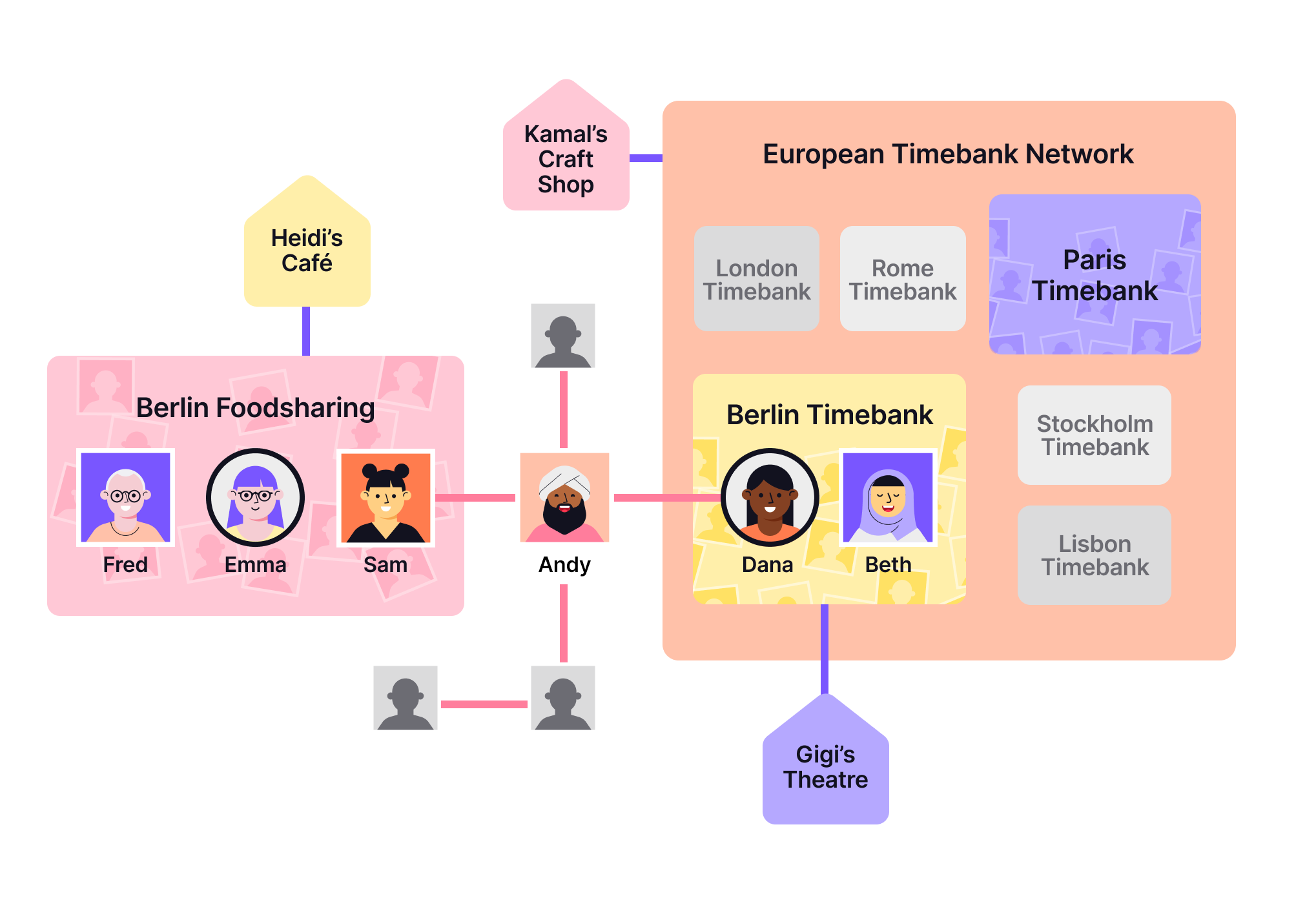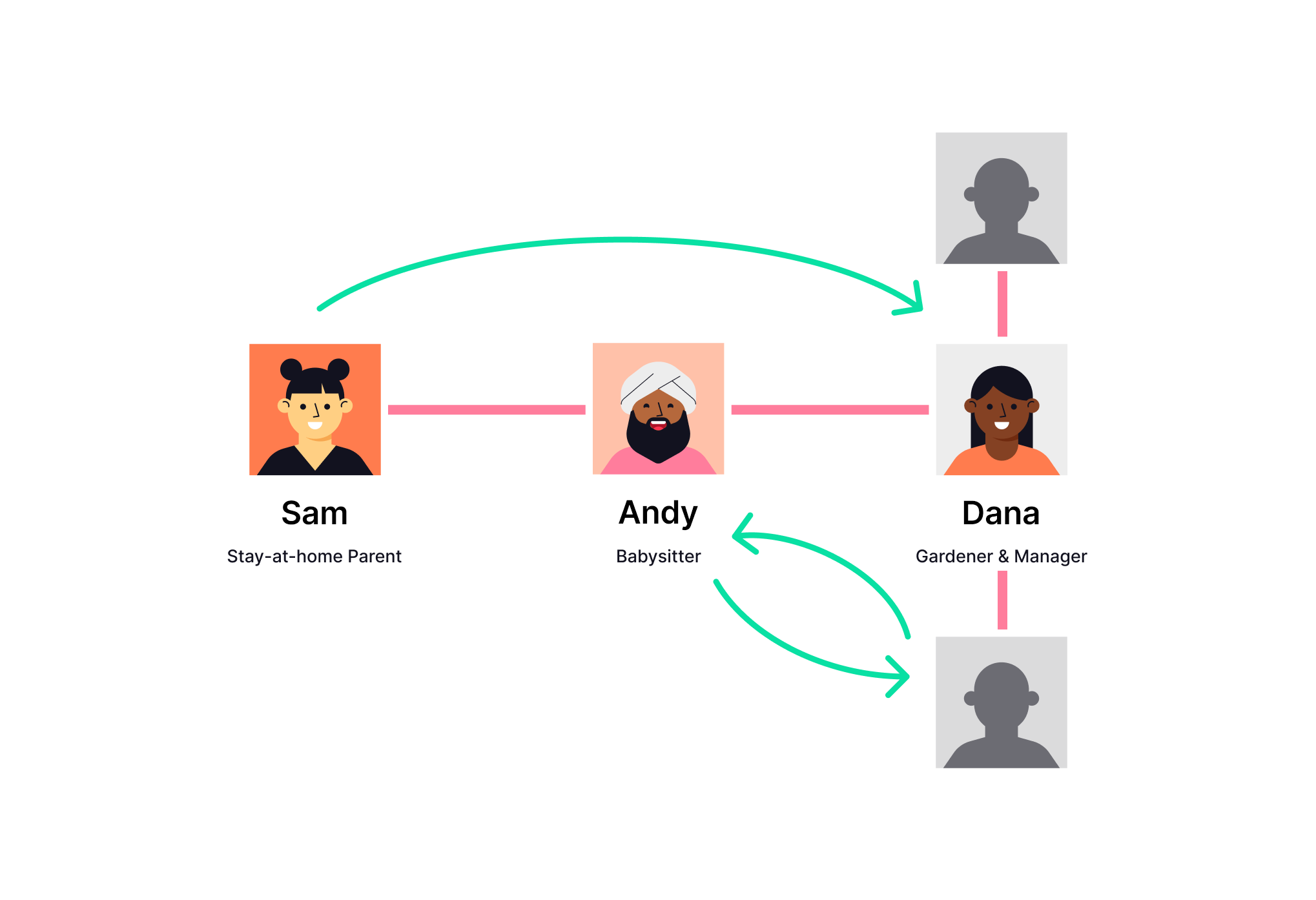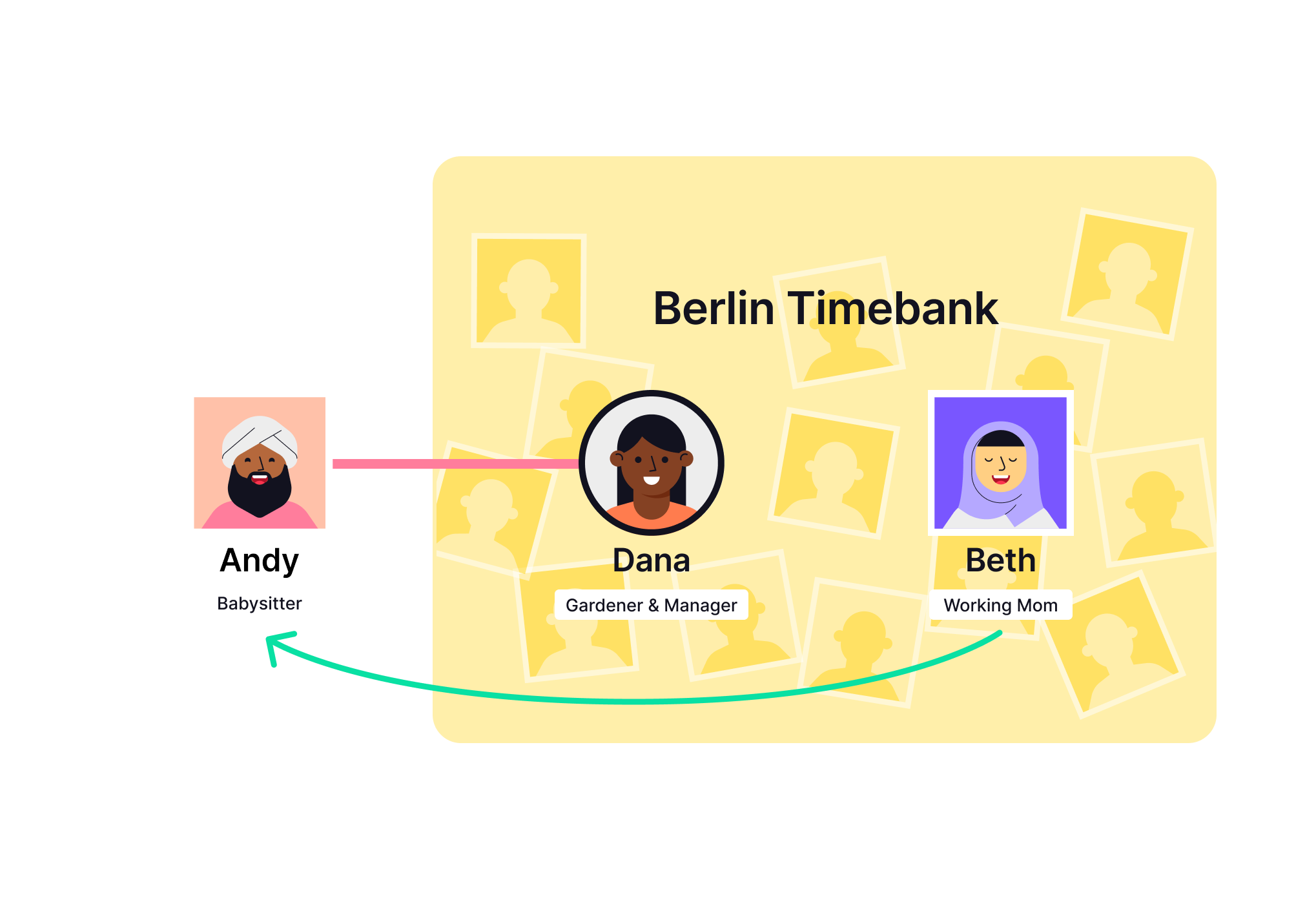Time credits (also referred to as time dollars or timebanking) are a form of alternative currency in which the unit of account is “time.” In other words, people receive a number of credits corresponding to the number of hours worked. Within most time credit systems, it is generally accepted that everybody’s time should be valued equally.
Implementing time credits can help revitalize community work by giving people the ability to track and reward unrecognized labor (sometimes as significant as a part-time job). It also allows those without financial resources to show tangible appreciation for received services. In addition, it empowers the recipients of services to view themselves as assets rather than just beneficiaries.
The last point is particularly important. Time credit systems focus on activating circular economies by encouraging all members to “pay it forward” rather than view themselves as only “givers” or “receivers.”
Top 3 reasons to use time credits for community work
- Reward volunteers for community work. This may help reduce burnout and sustain existing levels of community work, in addition to attracting broader participation.
- Empower recipients of services to view themselves as assets, with something to contribute to the community. Access untapped potential.
- Empower recipients of volunteer services to show tangible appreciation by giving credits to volunteers. This is particularly important for those who do not have the financial means to do so otherwise.
Launching a time credit system
Under a system of mutual credit, all value exchanges are simply debits and credits between entities that trust each other. One reason this works is due to value circulating evenly: Every member of the credit clearing system should be comfortable “lending” into the system because they know the value will eventually be repaid in another form. Just the same as with time credits, a circular economy is vital.
However, many time credit systems are limited by scalability problems due to their centralized nature. Because of the trust involved in creating an alternative economy, it is difficult for centralized systems to grow beyond the natural borders of a trusted community (in which the members really know each other). There are a few reasons for this:
- A small community creates a more intimate environment, which motivates people to look after their neighbors.
- If it gets too big, people may start to feel alienated from the community. This can make people feel less motivated to contribute.
- People are more trusting when the community consists of friends or friends-of-friends, so members can hold each other accountable.
- In a large community, people may lose faith that others will honor the value of their credits.
These problems of scalability are easily avoided when using Trustlines. Trustlines allows for a large-scale, interoperable network of time credits that prioritizes the self-governing nature of autonomous community work.
Why is this possible? Economic networks on Trustlines are based on existing trusted relationships, so natural economic borders emerge between communities where there are fewer trusted relationships. However, these communities remain connected at the edges—wherever they are naturally interconnected by individual friends and families.
Top 7 reasons to use Trustlines for time credits
- Trustlines enables a “decentralized timebank,” the easiest way to start using time credits.
- Community groups can facilitate direct transfers of value between members by providing a trusted intermediary. This is useful when the two individuals are strangers and are not willing to create a trustline.
- Businesses get a direct, granular way to support trusted community groups and individuals, by agreeing to accept their time credits as payment.
- Community groups can partner with other trusted organizations to facilitate direct transfers of value between members of their different communities. This is useful when people do not share direct trustlines.
- Community partnerships also expand both networks of partner businesses, thus growing the “spend” network of all volunteers.
- Volunteer groups will have a better ability to estimate the total number of hours their members plan to contribute over a set time period. This information is based on the capacity of the received credit limits.
- Using Trustlines would result in a transparent, public source of data to track the scope and impact of community work. Such transparency will be important in shaping future policy decisions)
Time Credits - User Stories
The following user stories are intended to illustrate possible ways to use Trustlines in a time credits system. They are meant to help guide you and to draw inspiration from them.

Decentralized Timebank
The easiest way to start using time credits is to join the decentralized timebank. Group clusters will occur around geographic areas or according to interest groups. For example, several individuals may want to start using time credits in the Berlin area.
Scenario 1: Decentralized Timebank.
Individuals can start using time credits independently, with anyone they trust. By doing so, they join the “decentralized timebank.”
Several people in Berlin become interested in the idea of timebanking and want to try it out. Some of them know each other from the neighborhood, and others share a coworking space. Others are just good friends. All of these connections are the basis for different trust relationships: Each person individually opens a trustline with the people they trust. Most people agree that five hours is a reasonable mutual credit limit for regular acquaintances.
Andy and Sam are neighbors. They open a trustline with each other because Sam has children, and Andy babysits once a week. Also, Sam has a car, and Andy sometimes needs a ride. They transact with each other often, so they set a mutual credit limit of ten. Even though it’s just the two of them, being able to track these exchanges using time credits has made the value of their services more visible, and mutually enriched their lives.

But it’s not just Andy and Sam. Dana, a gardener, is a good friend of Andy’s. They decide to open a trustline with a mutual credit limit of five. Even though Andy and Dana may not directly have skills to offer each other right now, they will each benefit from their trustline by being better connected to the rest of the network. For example, Dana offers gardening classes for children, and Sam’s children want to attend.

Similarly, Andy is a babysitter and would like Dana’s connections to be able to use his babysitting skills. In return, Andy can benefit from services provided by Dana’s connections.
Mutual Aid with a Neighborhood Timebank
In the traditional scenario, a Berlin neighborhood may start a centralized timebank, to encourage neighbors to share skills, support their neighbors, and enrich the community.
Scenario 2: Mutual Aid with a Neighborhood Timebank
Trustlines allows centralized timebanks to form. These are inherently interoperable with people outside the timebank, as well as other timebanks.
Everyone in Berlin is eligible to join the Berlin Timebank. The community elects Dana as a manager to monitor new applications.
Beth applies to join the timebank. Dana conducts an interview, in which she helps Beth figure out which skills to contribute, and what kind of requests to make. Beth signs a document committing to honor the principles of the timebank. Next, Dana has the Berlin Timebank create a trustline with Beth. The mutual credit limit on this trustline is 25, which is the same amount for all new members.
There are fifty members of the timebank, including Dana. Beth can now transact with all fifty members, by rippling payments through the organization account. But Beth’s overall balance with the timebank cannot go higher than 25 credits, and cannot go lower than -25 credits either. Beth offers to help Dana with her website, and enrolls her children in Dana’s gardening class. Beth and Dana can pay each other time credits by rippling through the Berlin Timebank.

Andy is a babysitter and wants to get paid for this service in time credits. But Andy is new to the neighborhood and does not feel comfortable applying for membership with a big neighborhood timebank. Luckily, Andy and Dana are good friends and share a trustline with a mutual credit limit of five. This connection enables Beth, who needs babysitting, to send a payment to Andy. Beth’s payment ripples first through the Berlin Timebank, then through Dana, before ending up with Andy.

Volunteer Groups
Time credits can also be used for more specific purposes. For example, the manager of an altruistic community group can use Trustlines to reward volunteers for their work. An added benefit of using Trustlines is they would be better able to estimate the total number of hours their volunteers plan to contribute over a set time period. They estimate this based on the received credit limits on their trustlines.
Scenario 3: Volunteer Groups
Trustlines allows organizations that coordinate specific community services, like Emma’s Foodsharing program in Berlin, to reward volunteers like Sam, by issuing time credits to them. Sam can spend earned credits with people and organizations that support Berlin Foodsharing. And Emma can share program statistics with her local government to demonstrate how important their work is.
Sam, a food delivery volunteer, opens a trustline with Berlin Foodsharing, managed by a chef, Emma. As a good rule of thumb, Sam should set the credit limit to be the maximum number of hours they expect to contribute over a set period of time. Sam expects to contribute ten hours per month, so they give Berlin Foodsharing a credit limit of ten. The other credit limit is zero for now. Emma can now pay Sam in time credits for food deliveries, using this trustline.

Sam begins accumulating time credits. Every month, Sam earns ten credits and then spends ten credits with connected people and organizations.
But one month, Sam earns ten credits and doesn’t spend them. Ten is the maximum amount of credits allowed by this credit limit. So next month, to continue earning credits, Sam agrees to raise Berlin Foodhsharing’s credit limit to 20. This enables Emma to pay Sam an additional ten credits that month.
Now Sam has accumulated 20 credits. But guess what, this month Sam adopts a new baby! Sam tells Emma that they will be busy parenting and no longer have time to volunteer. Sam decides to lower their credit limit to zero for now, to indicate less availability. Sam still has 20 earned credits and can spend them anytime, but can no longer earn new credits.
Now Sam is deep in diapers and really needs help. It’s a good time to talk to Andy, who can help out with babysitting. Andy will be able to earn credits directly from Sam, and also spend them through Sam, because of Sam’s accumulated credits with Berlin Foodsharing.
Direct Giving through Volunteer Groups
In a more advanced scenario, the manager of a community group could enable recipients of community services to pay volunteers directly. Using Trustlines helps the community group take a background role and act as a connector.
Scenario 4: Direct Giving through Volunteer Groups
Trustlines allows organizations that coordinate community services targeted towards helping vulnerable individuals, like Emma’s Foodsharing program in Berlin, to act as a trusted intermediary in facilitating direct value transfers between service recipients like Fred and volunteers like Sam.
Berlin Foodsharing opens a trustline with each service recipient that chooses to participate. Fred is a senior citizen with reduced mobility. He applies to be a recipient of Berlin Foodsharing. Emma arranges a visit to meet Fred and assesses a need for weekly meal deliveries. So, Emma has Berlin Foodsharing give Fred a monthly credit limit of four. This is enough to pay for deliveries four times each month. The other credit limit is zero for now. This trustline enables Fred to directly pay a time credit to Sam every week, by rippling through Berlin Foodsharing.

At the end of the month, Fred has a balance of negative four. To make sure Fred can keep paying next month, Emma keeps track of Fred’s balance. At the end of the month, Berlin Foodsharing gifts four credits to Fred, which resets his balance to zero. (Gifting is the practice of giving something voluntarily without payment in return.) This ensures that Fred can pay for next month’s deliveries.
Note that some months, Berlin Foodsharing doesn’t have to gift any credits to Fred. That’s because Fred can earn credits as well.
There’s more
Want to learn more? You can find many more user stories at the Trustlines Docs.

Get creative and start a timebank yourself! You can start a new one or on-board an existing community to it! The Trustlines ecosystem is here to help you with time credits. We look forward to hearing from you about your experiences. Feel free to drop by the Trustlines Forum to post your questions and share information about your community.

